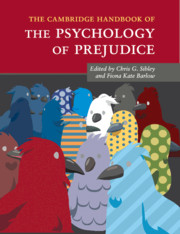Book contents
- Frontmatter
- Dedication
- Contents
- List of Figures
- List of Tables
- Notes on the Contributors
- Part I General Theoretical Perspectives
- 1 An Introduction to the Psychology of Prejudice
- 2 Evolutionary Approaches to Stereotyping and Prejudice
- 3 From Prejudice to Social Change: A Social Identity Perspective
- 4 Ingroup Projection as a Challenge of Diversity: Consensus about and Complexity of Superordinate Categories
- 5 Intergroup Discrimination: Ingroup Love or Outgroup Hate?
- 6 Intergroup Emotions Theory: Prejudice and Differentiated Emotional Reactions toward Outgroups
- 7 Intergroup Threats
- 8 Social Dominance Theory: Explorations in the Psychology of Oppression
- 9 The Dual Process Motivational Model of Ideology and Prejudice
- 10 Is Prejudice Heritable? Evidence from Twin Studies
- Part II Prejudice in Specific Domains
- Part III Prejudice Reduction and Analysis in Applied Contexts
- Index
- References
6 - Intergroup Emotions Theory: Prejudice and Differentiated Emotional Reactions toward Outgroups
from Part I - General Theoretical Perspectives
Published online by Cambridge University Press: 17 November 2016
- Frontmatter
- Dedication
- Contents
- List of Figures
- List of Tables
- Notes on the Contributors
- Part I General Theoretical Perspectives
- 1 An Introduction to the Psychology of Prejudice
- 2 Evolutionary Approaches to Stereotyping and Prejudice
- 3 From Prejudice to Social Change: A Social Identity Perspective
- 4 Ingroup Projection as a Challenge of Diversity: Consensus about and Complexity of Superordinate Categories
- 5 Intergroup Discrimination: Ingroup Love or Outgroup Hate?
- 6 Intergroup Emotions Theory: Prejudice and Differentiated Emotional Reactions toward Outgroups
- 7 Intergroup Threats
- 8 Social Dominance Theory: Explorations in the Psychology of Oppression
- 9 The Dual Process Motivational Model of Ideology and Prejudice
- 10 Is Prejudice Heritable? Evidence from Twin Studies
- Part II Prejudice in Specific Domains
- Part III Prejudice Reduction and Analysis in Applied Contexts
- Index
- References
Summary
As a man I pity you, but as an official I must show you no mercy; as a politician I regard him as an ally, but as a moralist I loathe him.
William James (1890/1983, p. 43)Emotions, William James tells us, are embedded in identity. How I feel about you depends not only on who you are, but also on who I am. In an influential chapter merging theories of social identity and emotion felt toward other groups, Smith (1993) similarly argued that considering intergroup attitudes as a combination of appraisals, emotions, and action tendencies based in the perceiver's social identity could better explain shifting intergroup evaluations across contexts and could better predict differentiated intergroup outcomes than traditional models of prejudice.
In the more than 20 years since the publication of that work, intergroup emotions theory (Mackie, Devos, & Smith, 2000; Mackie, Maitner, & Smith, 2009; Mackie & Smith, 2002, 2015; Smith & Mackie, 2006, 2008; Smith, Seger, & Mackie, 2007) has grown and developed into a comprehensive theory of intergroup relations that provides a complementary perspective to traditional attitude models of prejudice. In this chapter, we rearticulate the central tenets of the theory and then focus on how social categorization and group identification – who I am – interact with context to influence individuals’ appraisals, emotions, and behavioral intentions. We then focus on how three discrete emotional reactions elicit different and specific negative intergroup responses, before focusing on implications of intergroup emotions theory for improving intergroup relations. We finish with a discussion of current directions.
Intergroup Emotions Theory
Intergroup emotions theory (IET) suggests that when a particular social identity is activated, individuals will interpret events in terms of their implications for that ingroup, rather than for the individual personally. The more individuals identify with their currently activated social identity, the more extremely they will appraise group-relevant events. Group-based appraisals then elicit specific emotions and action tendencies. Because they are rooted in concerns for the group, we refer to such emotions as group based (see Niedenthal & Brauer, 2012). Intergroup relations are dynamic and ongoing, and thus individuals are expected to continuously reappraise changing situations, and their emotions to wax and wane, or amplify and change, along with changes in the intergroup context.
- Type
- Chapter
- Information
- The Cambridge Handbook of the Psychology of Prejudice , pp. 111 - 130Publisher: Cambridge University PressPrint publication year: 2016
References
- 8
- Cited by



